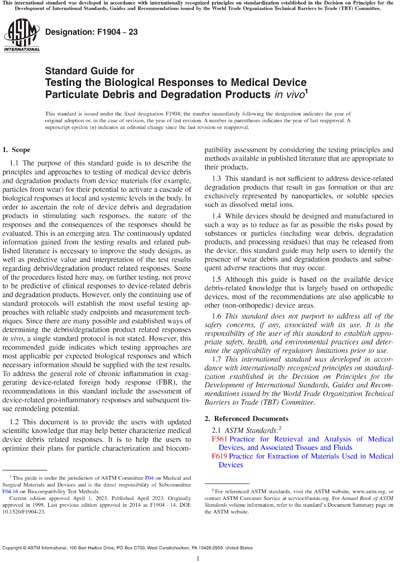Most recent
ASTM F1904-23
Standard Guide for Testing the Biological Responses to Medical Device Particulate Debris and Degradation Products in vivo
1.1The purpose of this standard guide is to describe the principles and approaches to testing of medical device debris and degradation products from device materials (for example, particles from wear) for their potential to activate a cascade of biological responses at local and systemic levels in the body. In order to ascertain the role of device debris and degradation products in stimulating such responses, the nature of the responses and the consequences of the responses should be evaluated. This is an emerging area. The continuously updated information gained from the testing results and related published literature is necessary to improve the study designs, as well as predictive value and interpretation of the test results regarding debris/degradation product related responses. Some of the procedures listed here may, on further testing, not prove to be predictive of clinical responses to device-related debris and degradation products. However, only the continuing use of standard protocols will establish the most useful testing approaches with reliable study endpoints and measurement techniques. Since there are many possible and established ways of determining the debris/degradation product related responses in vivo, a single standard protocol is not stated. However, this recommended guide indicates which testing approaches are most applicable per expected biological responses and which necessary information should be supplied with the test results. To address the general role of chronic inflammation in exaggerating device-related foreign body response (FBR), the recommendations in this standard include the assessment of device-related pro-inflammatory responses and subsequent tissue remodeling potential.
1.2This document is to provide the users with updated scientific knowledge that may help better characterize medical device debris related responses. It is to help the users to optimize their plans for particle characterization and biocompatibility assessment by considering the testing principles and methods available in published literature that are appropriate to their products.
1.3This standard is not sufficient to address device-related degradation products that result in gas formation or that are exclusively represented by nanoparticles, or soluble species such as dissolved metal ions.
1.4While devices should be designed and manufactured in such a way as to reduce as far as possible the risks posed by substances or particles (including wear debris, degradation products, and processing residues) that may be released from the device, this standard guide may help users to identify the presence of wear debris and degradation products and subsequent adverse reactions that may occur.
1.5Although this guide is based on the available device debris-related knowledge that is largely based on orthopedic devices, most of the recommendations are also applicable to other (non-orthopedic) device areas.
1.6This standard does not purport to address all of the safety concerns, if any, associated with its use. It is the responsibility of the user of this standard to establish appropriate safety, health, and environmental practices and determine the applicability of regulatory limitations prior to use.
1.7This international standard was developed in accordance with internationally recognized principles on standardization established in the Decision on Principles for the Development of International Standards, Guides and Recommendations issued by the World Trade Organization Technical Barriers to Trade (TBT) Committee.
Content Provider
ASTM International [astm]






